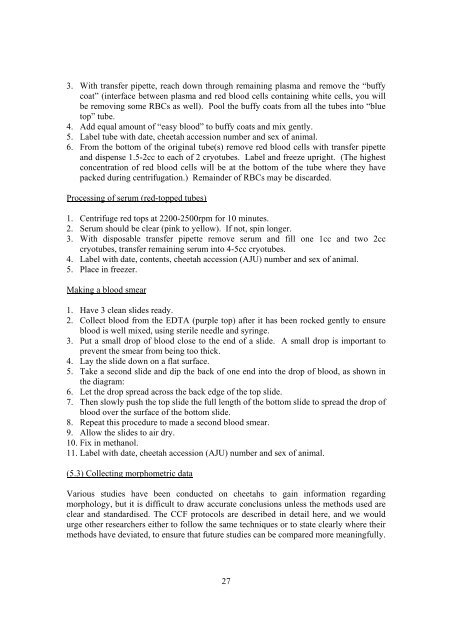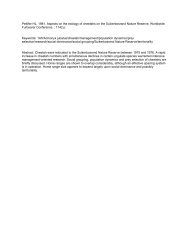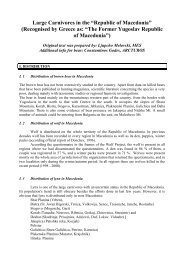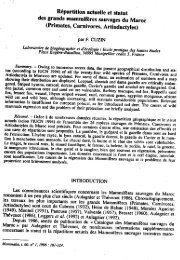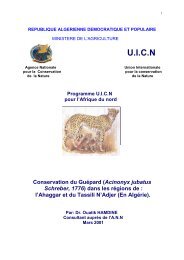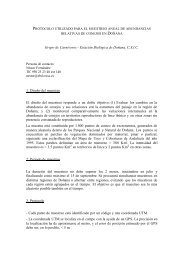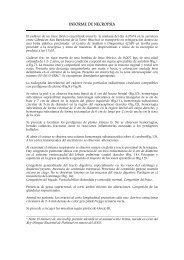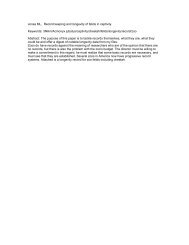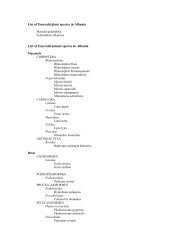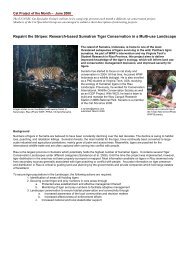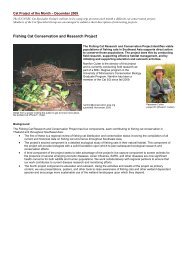cheetah capture and immobilisation handbook - Cat Specialist Group
cheetah capture and immobilisation handbook - Cat Specialist Group
cheetah capture and immobilisation handbook - Cat Specialist Group
Create successful ePaper yourself
Turn your PDF publications into a flip-book with our unique Google optimized e-Paper software.
3. With transfer pipette, reach down through remaining plasma <strong>and</strong> remove the “buffy<br />
coat” (interface between plasma <strong>and</strong> red blood cells containing white cells, you will<br />
be removing some RBCs as well). Pool the buffy coats from all the tubes into “blue<br />
top” tube.<br />
4. Add equal amount of “easy blood” to buffy coats <strong>and</strong> mix gently.<br />
5. Label tube with date, <strong>cheetah</strong> accession number <strong>and</strong> sex of animal.<br />
6. From the bottom of the original tube(s) remove red blood cells with transfer pipette<br />
<strong>and</strong> dispense 1.5-2cc to each of 2 cryotubes. Label <strong>and</strong> freeze upright. (The highest<br />
concentration of red blood cells will be at the bottom of the tube where they have<br />
packed during centrifugation.) Remainder of RBCs may be discarded.<br />
Processing of serum (red-topped tubes)<br />
1. Centrifuge red tops at 2200-2500rpm for 10 minutes.<br />
2. Serum should be clear (pink to yellow). If not, spin longer.<br />
3. With disposable transfer pipette remove serum <strong>and</strong> fill one 1cc <strong>and</strong> two 2cc<br />
cryotubes, transfer remaining serum into 4-5cc cryotubes.<br />
4. Label with date, contents, <strong>cheetah</strong> accession (AJU) number <strong>and</strong> sex of animal.<br />
5. Place in freezer.<br />
Making a blood smear<br />
1. Have 3 clean slides ready.<br />
2. Collect blood from the EDTA (purple top) after it has been rocked gently to ensure<br />
blood is well mixed, using sterile needle <strong>and</strong> syringe.<br />
3. Put a small drop of blood close to the end of a slide. A small drop is important to<br />
prevent the smear from being too thick.<br />
4. Lay the slide down on a flat surface.<br />
5. Take a second slide <strong>and</strong> dip the back of one end into the drop of blood, as shown in<br />
the diagram:<br />
6. Let the drop spread across the back edge of the top slide.<br />
7. Then slowly push the top slide the full length of the bottom slide to spread the drop of<br />
blood over the surface of the bottom slide.<br />
8. Repeat this procedure to made a second blood smear.<br />
9. Allow the slides to air dry.<br />
10. Fix in methanol.<br />
11. Label with date, <strong>cheetah</strong> accession (AJU) number <strong>and</strong> sex of animal.<br />
(5.3) Collecting morphometric data<br />
Various studies have been conducted on <strong>cheetah</strong>s to gain information regarding<br />
morphology, but it is difficult to draw accurate conclusions unless the methods used are<br />
clear <strong>and</strong> st<strong>and</strong>ardised. The CCF protocols are described in detail here, <strong>and</strong> we would<br />
urge other researchers either to follow the same techniques or to state clearly where their<br />
methods have deviated, to ensure that future studies can be compared more meaningfully.<br />
27


